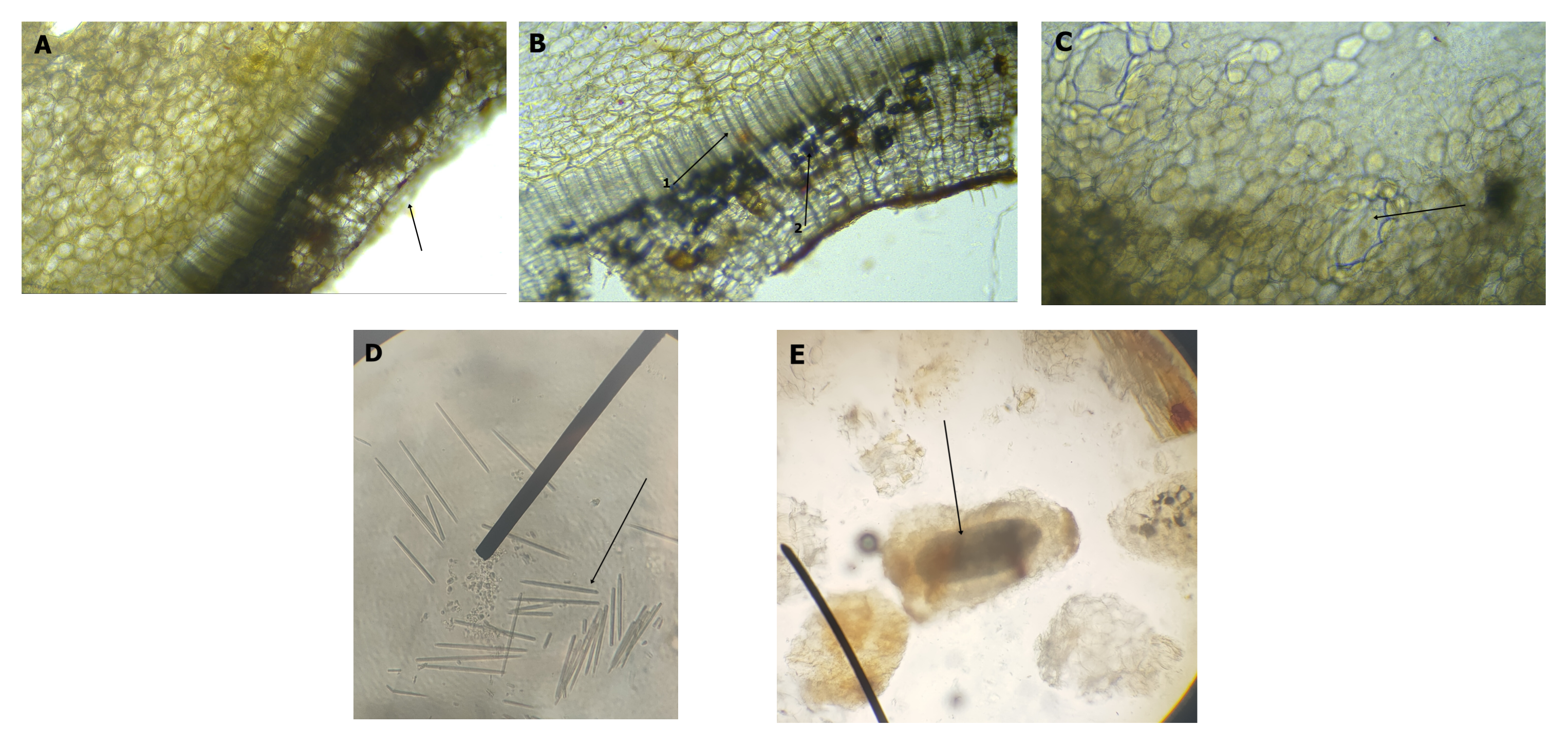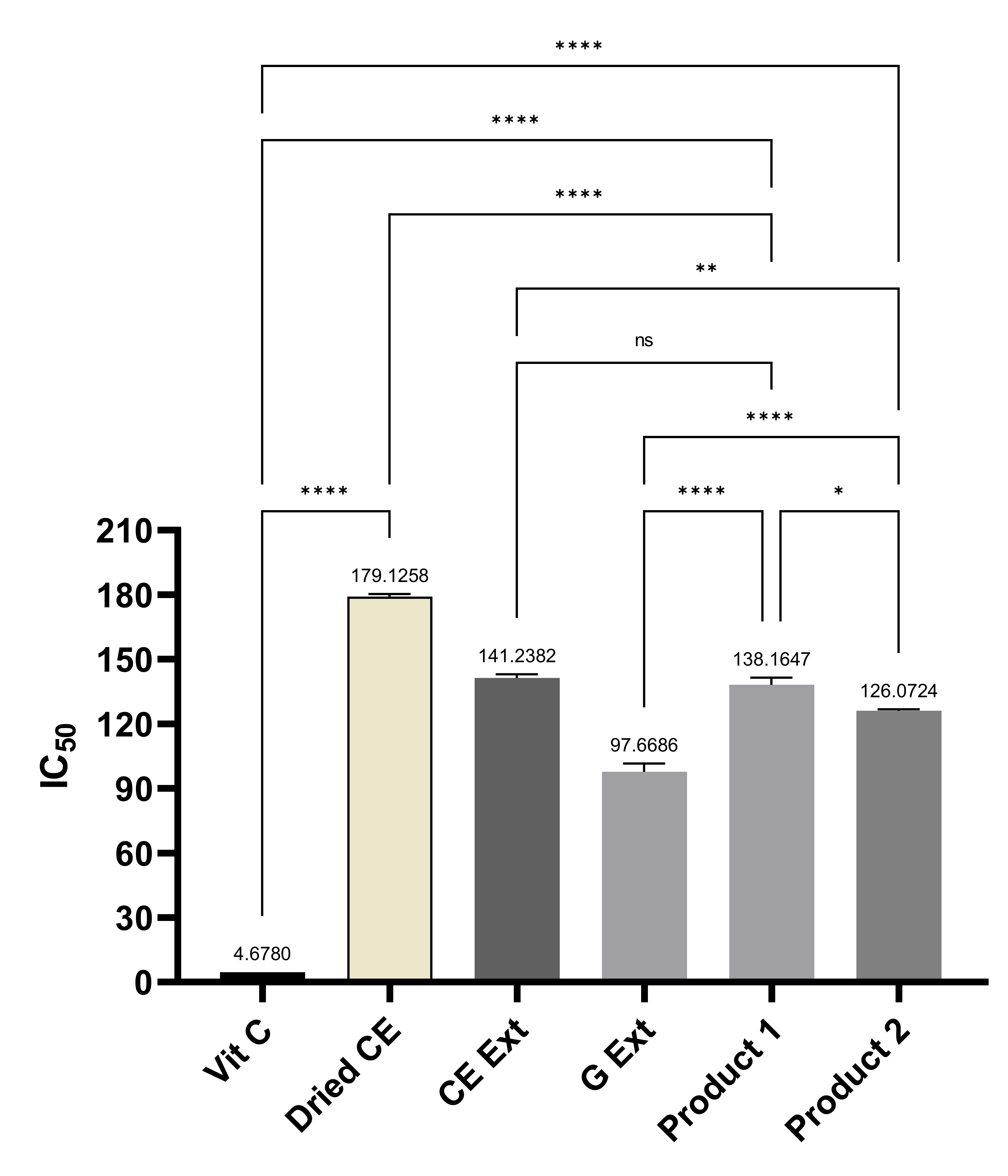Phenolic Content and Antioxidant Activity of Colocasia esculenta in Commercial Herbal Products
by Gumilar Adhi Nugroho , Yesi Desmiaty ★ , Yati Sumiyati , Sandra Loretta Suherman, Helsa Lim
Academic editor: Bharath Kumar Chagaleti
Sciences of Phytochemistry 4(1): 33-39 (2025); https://doi.org/10.58920/sciphy0401288
This article is licensed under the Creative Commons Attribution (CC BY) 4.0 International License.
01 Oct 2024
24 Jan 2025
07 Feb 2025
14 Mar 2025
Abstract: Taro (Colocasia esculenta L.) is a plant with a long history of use in traditional medicine in several countries worldwide. The corm of taro and two commercial products were analysed due to total phenolic, flavonoid, luteolin, and antioxidant properties. Taro corm was extracted with water and analysed for phytochemical screening, total flavonoids, total phenolic, luteolin, and antioxidant properties. The phytochemical screening of taro showed that it contains secondary metabolites of flavonoids, tannins, saponins, triterpenoids, and quinones. The results of the determination of total flavonoid content of taro extract, Product 1, and Product 2 capsule obtained 19.34 ± 0.26 mg QE/g extract, 18.58 ± 0.18 mg QE/g extract, and 16.29 ± 0.23 mg QE/g extract. The results of determining the total phenolic content of taro, Product 1, and Product 2 capsules obtained 39.75 ± 0.95 mg GAE/g extract, 38.46 ± 0.46 mg GAE/g extract, and 35.91 mg GAE/g extract. ± 0.82 mg GAE/g extract. The results of the determination of luteolin from taro, Product 1, and Product 2 capsules obtained 0.83 ± 0.05 %, 0.39 ± 0.04 %, and 0.18 ± 0.08 %. The results of the antioxidant activity test obtained IC50 of vitamin C of 4.6780 ± 0.0319 ppm, corm dry extract and ginger rhizome 141.2383 ± 3.4995 ppm and 97.6685 ± 7.8760 ppm, respectively, and capsule products 2; 126.0724± 1.3672 ppm. The water extract of corm and available products containing CE extract have met the quality standard parameters required for non-specific parameters, luteolin content, and antioxidant properties.
Keywords: AntioxidantTaro extractExtract standardizationIndonesian Herbs
Introduction
Taro, known as Colocasia esculenta (L.) Schott, a significant member of the Araceae family, is grown for its edible corms across the humid tropical and subtropical regions. Corms are regularly consumed and make a substantial contribution to a balanced and healthful diet in many areas, including the tropical Pacific islands (1). In many nations throughout the world, taro has a long history of usage in traditional medicine (2). The taro tribe (Araceae), which is a perennial or annual plant, includes taro. Flavonoids and saponins that include latex can be found in taro tubers. Phenolic, antibacterial, and antifungal substances including flavonoids and saponins can hasten the healing of wounds. Lectin is the primary protein found in the Araceae family, particularly in taro. Lectins play a part in immunological function, cell division, cell development, and body fat regulation (3). Antioxidants, particularly phenolic compounds, can be found in taro. Taro has bioactivity that is immunomodulatory, antioxidant, anticancer, antimetastatic, antimutagenic, hypoglycemic, and hypercholesterolemic. With a lower glycemic index than potatoes, taro is a viable food source option that may help lessen the incidence and prevalence of several diseases, including certain cancers (4).
The attractive yellow color of the flesh and fibers, depending on the cultivar, is caused by flavones like luteolin-6-C-hexoside-8-C-pentoside, schaftoside, homoorientin, isovitexin, orientin, luteolin-4'-O-glucoside, luteolin-7-O-glucoside, vitexin, and apigenin-7-O-glucoside, which are also present in corms (1, 5). In terms of both fresh and processed goods, taro has enormous promise, particularly as a biofunctional food (6). Oxalates, which limit the use of fresh corms and leaves and create an acrid taste, severe irritation, swelling, and blistering of mucous membranes in the mouth and throat, nevertheless, have a detrimental impact on the nutritional quality of most cultivars (2).
However, specific values for total flavonoid and phenolic content in taro are yet to be widely established. The existing products containing the taro extract were claimed as supplements for joint health. Among its numerous bioactive constituents, total flavonoids, total phenolic compounds, and luteolin assay have gained considerable attention due to their potential health benefits. In this article, we will delve into the significance of these compounds and antioxidant assay in taro corm, especially in extract and several existing products.
Methodology or Experimental Section
Plant Material and Extract Preparation
Taro corm was collected from Purwakarta, West Java, Indonesia at October 20th, 2022, and identified by the BRIN, Bogor, West Java (B.3312/II.6.2/DI.05.07/9/2022). The corm of taro was dried with food dehydrator at 40 °C for 12 h and powdered using milling machine. Taro extract was prepared by extracting 1 kg of powdered taro material with 5.0 L of water at 40 °C for 5 h. The extract was concentrated and dried using an food dehydrator at <50 °C for 3 h. Taro extract was analyzed for the non-specific parameters according to Indonesian Herbal Pharmacopoeia (8) and phytochemical screening for the existence of alkaloids, tannins, saponins, flavonoids, phenolic compounds, triterpenoid, steroids, and glycoside (9).
Preparation of Commercial Herbal Products Analysis
Product 1, a 500 mg capsule (containing 100% taro extract), and Product 2, a 500 mg capsule (containing 70% taro extract and 30% ginger extract), are both commercially available. Ten capsules were taken and 100 mg of capsule contents were weighed for the analysis. Then, 20 mL of 96% ethanol was added, shaken for 1 min, allowed to stand for 10 min, and filtered quantitatively. The obtained filtrate was used for the TFC, TPC, luteolin, and ABTS assay.
Microscopic analysis
The fresh corm of taro was sliced crosswise and lengthwise, and then taro powder was also used in the test. The preparation that has been prepared on the glass object was dripped with 1-2 drops of water or chloralhydrate and then heated over a Bunsen burner. Then, the preparations were covered by a cover glass and observed under a microscope.
Total Flavonoid Content Assay
The determination of total flavonoid levels was carried out spectrophotometrically ( Shimadzu UV-1610, Shimadzu Corporation, Japan) (10). Taro extract (25 mg) was dissolved in 5 mL of 95% ethanol. Absorption measurements were carried out at a wavelength of 435 nm. Measurement of total flavonoid levels was carried out using a calibration curve with quercetin as a positive control.
Total Phenolic Content Assay
Determination of total phenolic content was carried out spectrophotometrically using the Folin-Ciocalteu reagent using gallic acid as a reference standard (10). Taro extract (25 mg) was dissolved in 5 mL of 95% ethanol. Absorption measurements were carried out at a wavelength of 750 nm. Measurement of total phenolic content was carried out using the calibration curve of gallic acid.
Luteolin Assay with TLC-Densitometry
Luteolin levels in CE extracts and herbal preparations were determined by the TLC-Densitometry method. As much as 100 mg of CE extract samples or herbal preparations, dissolved in 5 mL of methanol (Merck) by ultrasonication for 30 min. Standard luteolin was dissolved in methanol and then diluted until there were 5 series of concentrations in the range of 40-120 ppm. Dab 5 µL of the sample and luteolin standard on the TLC plate (CAMAG). The mobile phase used was toluene-ethyl acetate-formic acid-methanol (3:3:0, 8:0, 2 v/v). The eluated TLC plate was scanned at a wavelength of 355 nm using the CAMAG TLC Scanner 3, CAMAG Scientific Inc. USA. Luteolin levels were obtained using a calibration curve.
ABTS (2,2-azinobis (3-ethylbenthiazoline-6-sulfonic acid)) Assay
The ABTS method was carried out spectrophotometrically at a wavelength of 734 nm (10). Ascorbic acid was used as the standard for this ABTS test (5 concentrations in the range of 20-60 ppm). Antioxidant testing was carried out by mixing 20 µL of Product 1 or 2 with 180 µL of ABTS solution, incubating in a dark room for 45 min at room temperature before measuring with spectrophotometry.
Statistical Analysis
Analysis of variance and Tukey post hoc test were used to identify significant differences among the groups. This analysis was performed using Graphpad Prism version 8.4.3 for Windows Results are presented as the mean ± SEM, and p < 0.05 denoted statistical significance.

Figure 1. Microscopic sections of the tuber (A-C) and powder (D-E) of Colocasia esculenta. A. Cork cell tissue; D. Needle of calcium oxalate crystals; and E. Idioblasts contain needle crystals of calcium oxalate.
Result and Discussion
Phytochemical Analysis
Based on the phytochemical screening of dried taro corm powder and dry extract, several secondary metabolites were identified, including flavonoids, saponins, tannins, phenols, quinones, and triterpenoids. These findings differ from those reported by Ladeska V. et al. (2021), who found that Japanese taro tubers contained alkaloids, terpenoids, flavonoids, saponins, phenols, and glycosides (6). Similarly, the results also contrast with the study by Krishnapriya T. V. and A. Suganthi, which examined the water extract of taro and reported the presence of alkaloids, flavonoids, saponins, quinones, and triterpenoids, while detecting no tannins, essential oils, or coumarins (7).
The primary difference observed in the present study was the absence of alkaloids in the phytochemical screening. Variations in phytochemical composition among studies can arise due to several factors, including differences in habitat, growth conditions, cultivation methods, and harvesting age, all of which may influence the levels of secondary metabolites in plants.
Microscopic Analysis
On cross-sectional microscopic examination of taro tubers, cork parenchyma (Figure 1A), cork phelloderm (Figure 1B), and idioblasts filled with calcium oxalate needle crystals (Figure 1E) were observed. No specific diagnostic fragments were identified in the tuber, except for calcium oxalate needle crystals (11), as these structures were commonly found in many other dried corm samples.
Microscopic examination of taro tuber powder revealed specific fragments, including calcium oxalate crystals (Figure 1D). The results indicated that the calcium oxalate crystals were present in the form of needle-like structures. These needle-shaped calcium oxalate crystals were observed in preparations with aqueous media, whereas calcium oxalate needle crystals enclosed within idioblasts were identified in preparations treated with chloral hydrate media.
Standardization Parameters for Dried Taro
Determination of ash content was carried out with the aim of knowing the content of inorganic and mineral compounds contained in dried CE. Inorganic compounds can come from physiological sources such as potassium, magnesium, calcium, and others. Inorganic compounds can also come from non-physiological sources such as pollutants that are still carried in the dried corm. Water soluble ash content and acid insoluble ash content are the remaining ash obtained from the determination of total ash content which is then dissolved in water and hydrochloric acid, respectively. Water soluble ash content shows the content of minerals in dried corm that are soluble in the addition of water, such as physiological metals. Acid insoluble ash content shows the content of compounds that are insoluble in hydrochloric acid such as Hg, Pb, Cd, and silicates derived from soil or sand.
Determination of ethanol soluble extractive content the solvent used is 96% ethanol because 96% ethanol is a universal solvent and can dissolve almost all organic compounds present in dried corm. The juice content is calculated in percent of the dried material. The remaining dried corm juice after the evaporation process in the oven is the juice dissolved in the solvent. Water soluble juice content indicates the presence of polar compounds, because during the maceration process, polar water can attract polar compounds in dried corm. While ethanol soluble juice content shows the presence of polar, semi-polar and non-polar compounds contained in the dried corm. Based on the results obtained in Table 1, the determination of water-soluble extractive content of Japanese taro tuber dried corm powder is 37.79% ± 3.20 % and ethanol soluble juice content is 2.44 ± 0.24 %. This gives an initial picture of Japanese taro tuber dried corm powder containing compounds more soluble in water solvents than ethanol.
Tabel 1. Non-specific parameters test of Colocasia esculenta extract.
Tests | Levels (%) |
Water-soluble extractive | 37.79 ± 3.20 |
Ethanol-soluble extractive | 2.44 ± 0.24 |
Total ash | 1.85 ± 0.31 |
Water-soluble ash | 0.85 ± 0.04 |
Acid-insoluble ash | 0.34 ± 0.02 |
Note: data presented in mean ± SEM | |
The dried taro sample demonstrated a high content of polar compounds, as reflected by the significant water-soluble extractive value of 37.79%. In contrast, the content of semi-polar and non-polar compounds was relatively low at 2.44%. The total ash content was 1.85%, while the acid-insoluble ash content was 0.34%, both of which fall within low ranges, indicating good physical quality with minimal contamination from inorganic materials such as sand or soil. Furthermore, the water-soluble ash value of 0.85% suggested that only a small proportion of the minerals in the sample were soluble in water, further supporting the sample’s purity and quality.
Total Phenolic Content, Total Flavonoid Content, and Luteolin Assay
Flavonoids and phenolic compounds are secondary metabolites found abundantly in plants. They exhibit antioxidant, anti-inflammatory, and anticancer activities, making them valuable in promoting human health. Taro has been reported to contain varying amounts of these compounds, contributing to its medicinal properties.
One prominent flavonoid identified in Colocasia esculenta is luteolin. Luteolin is a flavone compound that displays potent antioxidant and anti-inflammatory properties. Its presence in taro has been linked to potential therapeutic effects against cancer, cardiovascular diseases, and neurodegenerative disorders. However, the specific concentration of luteolin in Colocasia esculenta can vary depending on factors such as cultivar, cultivation conditions, and harvest time. Of the three levels, it was shown that in the capsule samples, both capsules containing only taro tuber extract and those containing a mixture of ginger and Japanese taro extracts had lower luteolin levels compared to taro tuber extract. This is due to the different doses of taro tuber extract contained in the capsule preparations.
From the samples, it shows that in product samples (Table 2), both products containing Japanese taro tuber extract alone and those another, containing a mixture of ginger and Japanese taro extracts have lower luteolin content values compared to Japanese taro tuber extract. This is due to the difference in the dose of taro tuber extract contained in the capsule preparation. However, based on the calculation of luteolin content, it shows that the capsule product containing Japanese taro tuber extract contains luteolin flavonoid compounds that can be determined.
The test results revealed significant differences in total flavonoid levels, total phenolic levels, and luteolin levels between Japanese taro tuber extract and Product 1. These differences suggest that various factors influence the levels of flavonoids, phenolics, and luteolin between extracts and Japanese taro tuber-based products, one of which is the combination of ingredients in the product. In Product 2, the addition of other components reduced the extract's proportion, resulting in lower levels of flavonoids, phenolics, and luteolin compared to pure Japanese taro extract.
Table 2. Total phenolic content, total flavonoid content, and luteolin content of commercial herbal products containing Colocasia esculenta.
Parameters | CE Crude Extract | Product 1 | Product 2 |
Total Phenolic Content (mg GAE/g extract) | 39.75 ± 0.48 | 38.46 ± 0.23 | 35.91 ± 0.41ab |
Total Flavonid Content (mg QE/g extract) | 19.34 ± 0.13 | 18.58 ± 0.092a | 16.30 ± 0.12ab |
Luteolin (%) | 0.83 ± 0.03 | 0.39 ± 0.01a | 0.18 ± 0.01a |
Note: data presented in mean ± SEM, significantly different from CE Crude Extract (a; p < 0.05); significantly different from Product 2 (b; p < 0.05). | |||

Figure 2. ABTS Assay comparing Vitamin C, CE extract, dried CE, Ginger Extract, Product 1 (containing 100% CE extract), and Product 2 (containing CE and ginger extract). Data are presented as mean ± SEM.
Antioxidant Assay
Figure 2 illustrates that the antioxidant activity of vitamin C, used as the standard reference, was significantly higher than that of all other samples. A notable difference in antioxidant activity was also observed between taro simplicia and taro extract, with the extract exhibiting a higher antioxidant value. When comparing the antioxidant values of taro extract and Product 1 (which contains 100% taro extract), no significant difference was detected. However, Product 2 (which contains both taro extract and ginger extract) displayed a lower antioxidant value than Product 1, likely due to the lower concentration of taro extract in its formulation.
The antioxidant activity of the dried Japanese taro tuber extract was assessed using the ABTS (2,2-azino-bis(3-ethylbenzothiazoline-6-sulfonic acid)) assay. Antioxidant activity was expressed as IC50, where a lower IC50 value indicates stronger antioxidant activity. The ABTS method was selected for its advantages, including specific absorbance in the visible wavelength range, rapid reaction times, and solubility in both organic solvents and water, allowing for the detection of both lipophilic and hydrophilic compounds.
The principle of the ABTS assay is based on the decolorization of ABTS cation radicals, which measures the antioxidant capacity of compounds that directly interact with these radicals. Antioxidant compounds, particularly phenolics, contribute by donating hydrogen atoms from hydroxyl groups, resulting in the reduction of ABTS radicals and a color change from blue-green to colorless. Vitamin C was used as a positive control, as it is well-documented for its strong antioxidant properties. The ABTS assay is widely recognized for its flexibility, sensitivity, and compatibility with various sample types, making it particularly suitable for research involving complex extracts, foods, beverages, and natural products with diverse antioxidant compositions (12).
Conclusion
The phytochemical analysis of dried taro corm powder and its extract revealed flavonoids, saponins, tannins, phenols, quinones, and triterpenoids, with no alkaloids detected. Microscopic analysis showed calcium oxalate needle crystals in both tuber and powdered forms. Standardization tests indicated a high content of polar compounds (37.79%) and low inorganic contamination. The total phenolic, flavonoid, and luteolin levels in commercial products were lower than in the crude extract, mainly due to differences in formulation. Antioxidant testing using the ABTS assay showed that vitamin C had the highest activity, with taro extract demonstrating stronger antioxidant potential than dried simplicia. Product 2, containing less taro extract, exhibited lower antioxidant activity. These results underscore the impact of extraction methods and product formulation on the phytochemical composition and bioactivity of taro-based products.
Declarations
Ethics Statement
Not applicable.
Data Availability
The unpublished data is available upon request to the corresponding author.
Funding Information
Matching Fund (2022) grant from the Ministry of Education, Culture, Research and Technology of the Republic of Indonesia
Conflict of Interest
The authors declare no conflicting interest.
References
- Lebot V, Lawac F, Michalet S, Legendre L. Characterization of taro [Colocasia esculenta (L.) Schott] germplasm for improved flavonoid composition and content. Plant Genet Resour Characterisation Util. 2017;15(3):260–8. doi: 10.1017/S1479262115000581.
- Sudhakar P, Thenmozhi V, Srivignesh S, Dhanalakshmi M. Colocasia esculenta (L.) Schott: Pharmacognostic and pharmacological review. J Pharmacogn Phytochem. 2020;9(4):1382–6. doi: 10.22271/phyto.2020.v9.i4s.11937.
- Goncalves RF, Campos D, Santos M, Rocha F, Pinheiro J, Silva S, et al. Influence of taro (Colocasia esculenta L. Schott) growth conditions on the phenolic composition and biological properties. Food Chem. 2013;141(4):3480–5. doi: 10.1016/j.foodchem.2013.06.009.
- Pereira PR, Mattos ÉBDA, Corrêa ACNTF, Vericimo MA, Paschoalin VMF. Anticancer and immunomodulatory benefits of taro (Colocasia esculenta) corms, an underexploited tuber crop. Int J Mol Sci. 2021;22(1):1–33. doi: 10.3390/ijms22010265.
- Muñoz-Cuervo I, Malapa R, Michalet S, Lebot V, Legendre L. Secondary metabolite diversity in taro, Colocasia esculenta (L.) Schott, corms. J Food Compos Anal. 2016;52:24–32. doi: 10.1016/j.jfca.2016.07.004.
- Ladeska V, Am RA, Hanani E. Colocasia esculenta L. (Taro Plant): Study of pharmacognosis, phytochemical, and pharmacological activity. J Sains Kesehat. 2021;3(2):351–8. doi: 10.25026/jsk.v3i2.457.
- Krishnapriya TV, Suganthi A. Biochemical and phytochemical analysis of Colocasia esculenta (L.) Schott tubers. Int J Res Pharm Pharm Sci. 2017;2:2455–98. [Internet]. Available from: www.pharmacyjournal.in.
- Ministry of Health. Indonesia Herbal Pharmacopoeia. 2nd ed. Jakarta: Ministry of Health, Republic of Indonesia; 2017.
- Ikan R. Natural products—A laboratory guide. 2nd ed. California: Academic Press Inc.; 1991.
- Chatatikun M, Chiabchalard A. Thai plants with high antioxidant levels, free radical scavenging activity, anti-tyrosinase and anti-collagenase activity. BMC Complement Altern Med. 2017;17(1):1–9. doi: 10.1186/s12906-017-1994-7.
- Kristl J, Sem V, Mergeduš A, Zavišek M, Ivančič A, Lebot V. Variation in oxalate content among corm parts, harvest time, and cultivars of taro (Colocasia esculenta (L.) Schott). J Food Compos Anal. 2021;102:104001. doi: 10.1016/j.jfca.2021.104001.
- Floegel A, Kim DO, Chung SJ, Koo SI, Chun OK. Comparison of ABTS/DPPH assays to measure antioxidant capacity in popular antioxidant-rich US foods. J Food Compos Anal [Internet]. 2011;24(7):1043–8. Available from: http://dx.doi.org/10.1016/j.jfca.2011.01.008.

 ETFLIN
Notification
ETFLIN
Notification







